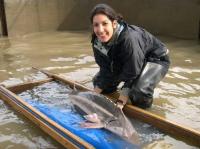
Dr. Phaedra Doukakis of Rosenstiel School's Pew Institute for Ocean
Science with one of the studied sturgeon. Scientists working in the Ural River, Kazakhstan, have successfully attached Pop-up Archival Transmitting (PAT) tags to four sturgeons and have released the animals into the Caspian Sea, hoping to get a clear picture of Caspian Sea sturgeon movement and behavior never before available.
Led by Dr. Phaedra Doukakis of the University of Miami's Pew Institute for Ocean Science and scientists from the Research and Production Center for the Fish Industry of the Republic of Kazakhstan and in collaboration with Daniel Erickson of the Wildlife Conservation Society, this study of three beluga (Huso huso) sturgeons and one adult ship (Acipenser nudiventris) sturgeon is a rare collaboration between Kazakhstani and American scientists.
"This study is precedent setting," says Dr. Doukakis. "It is the first to use satellite tagging to study Caspian Sea sturgeons. Kazakhstan has taken a giant leap forward with this research and set an example for other Caspian nations to follow. What we learn will be critical for conservation of these highly endangered sturgeons."
Collecting data every minute for a specified period of time and then relaying the archived information to scientists, satellite tags are an increasingly important tool for studying fish biology, especially for sturgeons. Mr. Erickson was the first to apply satellite technology to study sturgeon, using it with green sturgeon on the west coast of the United States.
"These tags provide a window into species biology and behavior not available to us previously," he says. "We will undoubtedly learn things that will challenge long-held assumptions and contribute to better management."
Caspian Sea beluga sturgeon have suffered severe declines in recent times, with estimates suggesting a 90 percent decline over the last two decades. The Ural River is home to the last great population of the beluga and is the only place where beluga reproduces naturally and unhindered by dams. Preserving this population is vital to ensuring natural replenishment of Caspian beluga.
"The outlook for wild sturgeon populations around the world is bleak, especially for beluga and ship sturgeon, which have been overfished to an extreme and are the most endangered of all Caspian species," says Dr. Ellen Pikitch, executive director of the Pew Institute for Ocean Science at the UM Rosenstiel School of Marine and Atmospheric Science and founder of the research project. "Beluga sturgeon now have a chance at survival thanks to studies such as these and the recent CITES ban on international trade in most all Caspian Sea caviars."
Beluga and other Caspian sturgeons recently received a reprieve from trade pressures thanks to action by the Convention on International Trade of Endangered Species of Wild Flora and Fauna (CITES) and US listing of beluga under the Endangered Species Act, which effectively banned beluga caviar import into the US. Controlling legal and illegal fishing in Caspian Sea range states and undertaking scientific research is now critical for continued survival of the species.
Last fall, Dr. Pikitch, along with Dr. Doukakis and Mr. Erickson published the first ever global review of sturgeon populations in the journal Fish and Fisheries. Local extinctions were reported in 19 of 27 species, and the Caspian Sea beluga and ship sturgeon populations were among the most critical.
Source : University of Miami Rosenstiel School of Marine & Atmospheric Science
 Print Article
Print Article Mail to a Friend
Mail to a Friend
